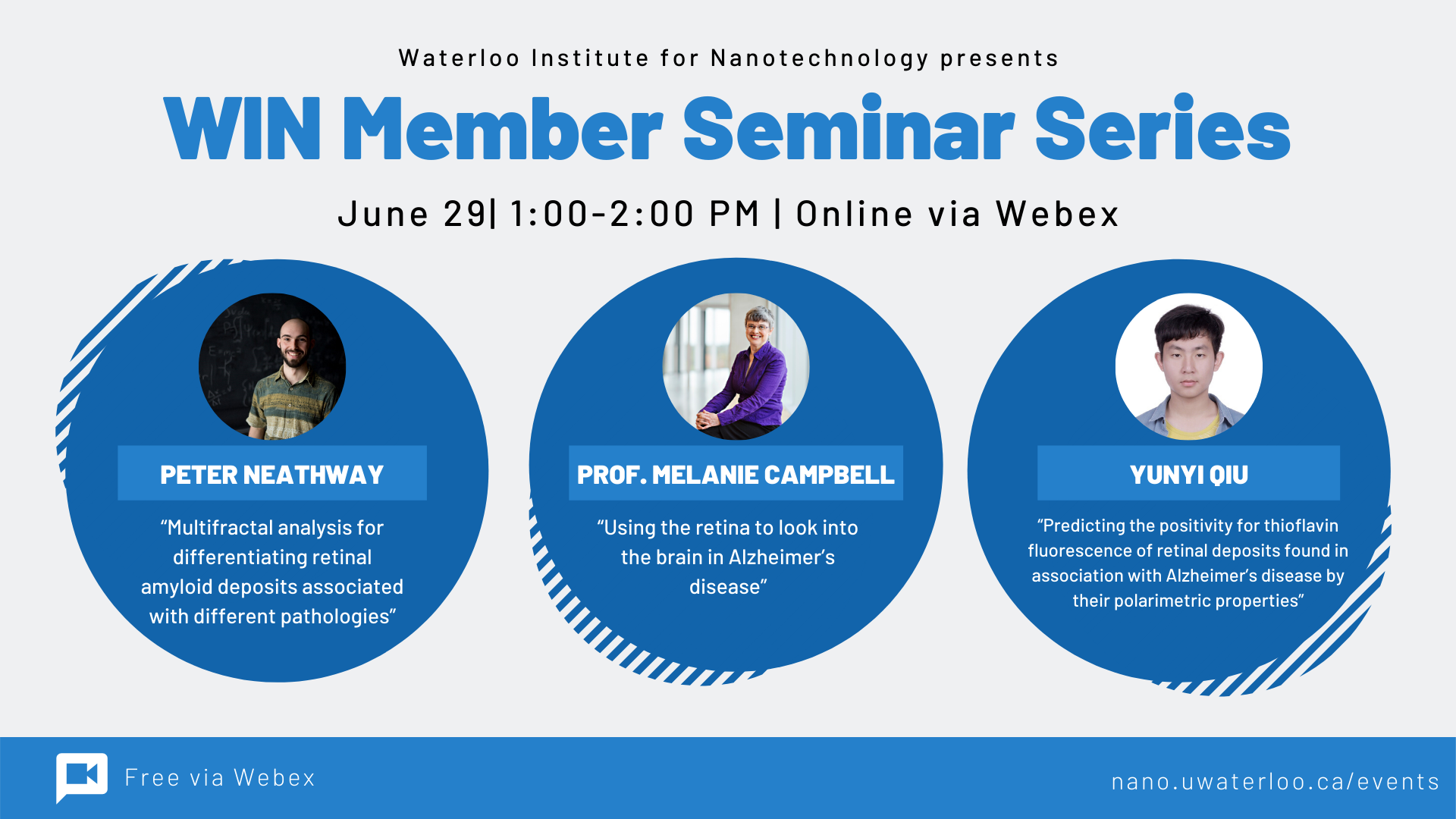
This seminar is being delivered via WebEx.If you would like to pre-register and receive a calendar invitation, please email win-office@uwaterloo.ca.
Using the retina to look into the brain in Alzheimer’s disease
Professor
Melanie
Campbell
Department
of
Physics
and
Astronomy
&
School
of
Optometry
and
Vision
Science
 The
retina
forms
as
an
outpouching
of
the
brain
and,
like
the
brain,
contains
neural
cells.
Thus,
we
expected
and
have
confirmed
that
deposits
of
amyloid
protein
form
in
the
retinal
neural
cell
layers,
analogous
to
their
formation
in
the
brain
early
in
the
Alzheimer’s
disease
(AD)
process.
Our
patented
technique,
using
polarized
light
without
a
dye,
can
identify
presumed
amyloid
deposits
with
100%
sensitivity
in
retinas
of
those
with
a
diagnosis
of
AD.
In
addition,
the
number
of
deposits
predicts
the
severity
of
amyloid
pathology
in
the
brain
and
the
overall
severity
of
the
disease
pathology.
This
technique
holds
great
promise
as
an
earlier,
less
invasive,
readily
available
diagnostic
which
will
enable
less
expensive
testing
of
promising
treatments
and
earlier,
more
accurate
disease
diagnosis.
The
retina
forms
as
an
outpouching
of
the
brain
and,
like
the
brain,
contains
neural
cells.
Thus,
we
expected
and
have
confirmed
that
deposits
of
amyloid
protein
form
in
the
retinal
neural
cell
layers,
analogous
to
their
formation
in
the
brain
early
in
the
Alzheimer’s
disease
(AD)
process.
Our
patented
technique,
using
polarized
light
without
a
dye,
can
identify
presumed
amyloid
deposits
with
100%
sensitivity
in
retinas
of
those
with
a
diagnosis
of
AD.
In
addition,
the
number
of
deposits
predicts
the
severity
of
amyloid
pathology
in
the
brain
and
the
overall
severity
of
the
disease
pathology.
This
technique
holds
great
promise
as
an
earlier,
less
invasive,
readily
available
diagnostic
which
will
enable
less
expensive
testing
of
promising
treatments
and
earlier,
more
accurate
disease
diagnosis.
Multifractal analysis for differentiating retinal amyloid deposits associated with different pathologies
Peter
Neathway
Masters
of
Science,
Physics
-
Nanotechnology
student
Amyloid-laden deposits with intrinsic polarization signals form in the retina in association with Alzheimer’s disease. Similar deposits also seem to form in association with other ocular conditions, like age-related macular degeneration, and in association with various brain pathologies. Linear retardance is the polarization signal that provides the strongest contrast between deposits and retinal surround. Multifractal analysis (MFA) is a means of representing the complexity/texture of a set as a spectrum and has been used in a variety of biomedical imaging applications. This work demonstrated that MFA of linear retardance maps could statistically differentiate between deposits associated with various pathologies, as could polarization signals. These results indicate the potential of MFA and polarimetry for diagnostic purposes.
Predicting the positivity for thioflavin fluorescence of retinal deposits found in association with Alzheimer’s disease by their polarimetric properties
Yunyi
Qiu
Master
of
Science,
Physics
student
Alzheimer’s disease (AD) is a neurodegenerative disease which leads to cognitive impairment and ultimately death. Amyloid deposits composed of misfolded amyloid-β protein serve as the hallmarks for AD. Thioflavin is a fluorescent marker for amyloid, including amyloid-β. Here, we present three machine learning methods with the aim of predicting when retinal deposits found in association with AD are positive in thioflavin fluorescence from their interaction with polarized light, without using a dye. Two oversampling strategies were applied to overcome data imbalance. This research demonstrated that thioflavin positivity of retinal amyloid deposits can be predicted from their polarimetry images. These results indicate polarimetry is a promising dye free method of detecting amyloid deposits in ex vivo retinal tissue.